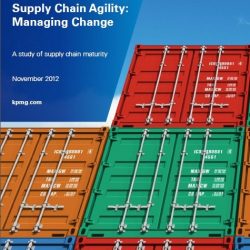Supply Chain Agility: Managing Change

KPMG’s latest report on supply chain maturity investigates how supply chain directors are managing in this uncertain world and seeks to understand how supply chains have matured since our survey last year. The report is a result of 80 interviews with supply chain directors from around the world and summarises the key issues facing them today.
Key findings:
- Identifying opportunities to squeeze further costs out of the end-to-end supply chain to drive profitability; and understand the true supply chain cost to serve
- Developing more effective responses to demand volatility in order to manage fluctuations and reduce costs
- Reorienting their operational processes with a ‘LEAN flavor’ to enhance flexibility while maintaining efficiency
Executive Summary
It seems to all come down to volatility: Economic volatility (the Eurozone crisis and anemic economic growth) compounded with political volatility (elections in the US and on-going turmoil in the Middle East) have led to business volatility (bankruptcies, insolvencies and increased regulation) and supply chain volatility (demand fluctuations and gyrating input costs). That’s a lot of volatility.
It should come as no surprise, therefore, that KPMG’s interviews indicate that supply chain directors are now increasingly focused on those activities that help them reduce the impact of volatility, enhance flexibility and drive out costs. And while some seem to still be taking short-term actions in order to weather the storm, others are pursuing new approaches and reorganizing their operating models to turn volatility into opportunity.
- By comparing the results of the 2012 interviews with those from last year, we noted three areas in particular that supply chain directors and corporate executives were particularly focused on:
- Identifying opportunities to squeeze further costs out of the end-to-end supply chain to drive profitability; and understand the true supply chain cost to serve.
- Developing more effective responses to demand volatility in order to reduce fluctuations and reduce costs.
Reorienting their operational processes with a ‘LEAN flavor’ to enhance flexibility while maintaining efficiency.
Our interviews also uncovered a number of emerging and continuing trends that are influencing the supply chain environment. Some organizations are moving towards globally integrated Sales and Operations Planning processes to create more alignment across the supply chain, while others are setting up shared service centers to centralize order taking, financing, logistics planning and elements of logistics execution. More revolutionary still will be the widespread adoption of cloud services within the supply chain.
Overall, our analysis of the interviews reveals that supply chain maturity has generally increased, though some areas – such as supply chain risk, cost to serve analysis and sustainability – still seem to be slow to develop in many sectors and geographies. In part, this may be due to challenges recruiting and retaining skilled operators. Indeed, across almost all of the markets and industries we interviewed, we found that high-quality talent was a scarce resource.
While supply chain maturity levels have remained broadly stable when compared to our 2011 results, our interviews revealed that respondents are re-evaluating their maturity in key functional areas based on the lessons learned over the past year of supply chain challenges. Looking across the sectors, however, we find that participants from the Diversified Industrials, Consumer Packaged Goods (CPG) and Logistics sectors tended to demonstrate the highest levels of supply chain maturity overall. Participants reported the highest overall maturity in their capabilities around Customer Relationship Management and Supplier Relationship Management, but were less optimistic about their maturity in Sales & Operations Planning, Working Capital and Supply Chain Risk Management.









